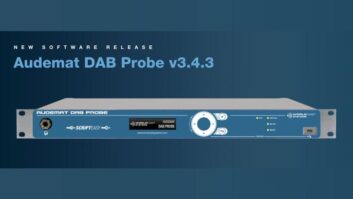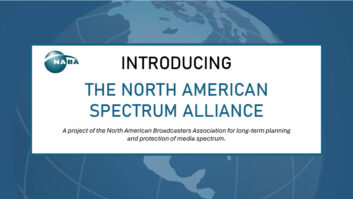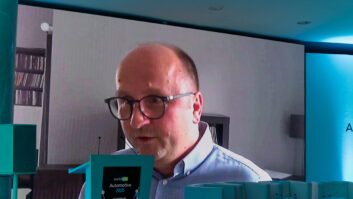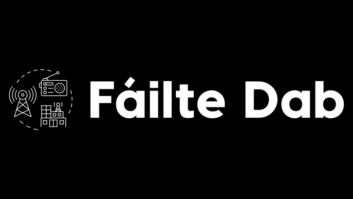Canada Considers Subscription Radio Services, Including Eureka-147 Terrestrial Broadcasting
Canada has been a long and strong supporter of the Eureka-147 DAB format for its transition path to digital radio. The country’s plan has been to replace AM and FM broadcasting eventually with an equivalent number of Eureka channels in the international L-band DAB allocation of 1452-1492 MHz.
Deployment has been steadily implemented over the last several years, and DAB operations now serve several major metro areas across the country with simulcasts of selected local AM and FM channels. (At last count, there were 25 active DAB channels in Toronto, 15 in Vancouver, 12 in Montreal, six in Windsor and four in Ottawa.)
The Canadian experience has been little different from other countries taking a pure simulcast approach, however. Despite substantial marketing efforts and on-air promotion, DAB has not been a strong seller to Canadian consumers to date, even though Canada has perhaps the lowest-cost DAB receivers available anywhere (<$100 CDN, or ~$75 US). As a result, DAB radios are not widely available, either at retail or as automotive options.
Meanwhile, a significant gray market has developed for U.S. satellite radio receivers in Canada. Because over 75 percent of the Canadian population lives within 200 miles of the U.S. border, XM and Sirius satellite radio services have reasonable potential access to the market. For Canadian residents living within this spillover coverage area, all that is required to obtain either service is a U.S. billing address and a receiver.
A proactive solution path
In December 2003, Canada’s Radio-television and Telecommunications Commission (CRTC, the Canadian regulatory equivalent of the U.S. FCC) issued a call for applications for multichannel subscription radio services. This was not so much in response to the lagging uptake of DAB as it was to unsolicited satellite radio proposals from U.S. satellite radio operators and some Canadian partners. (A policy aimed at thwarting growth of gray-market satellite radio usage was probably also involved.)
So it came as no surprise that once the CRTC issued this call, two proposals were soon received. One of these came from a newly formed company called Canadian Satellite Radio or CSR, a joint venture of Canadian entrepreneur and former Toronto Raptors owner John Bitove Jr. and XM Satellite Radio Holdings. The other was submitted by the national public broadcast organization of Canada, the Canadian Broadcast Corp. (CBC/Radio Canada), in partnership with Sirius Satellite Radio and Standard Radio Inc. The latter is the Canada’s largest commercial radio station group, with approximately 50 radio stations plus TV, online and program syndication properties.
Both the CSR and CBC proposals would leverage existing S-band (2320-2345 MHz) digital radio satellite services – XM’s and Sirius’, respectively – repackaged for Canadian audiences with somewhat different channel lineups than those currently offered by the two services in the United States.
CSR’s proposes 101 channels, four of which would be produced in Canada, for a monthly fee of $12.99 Canadian. CBC proposes 78 channels, with four produced by CBC, for a $12.95 CDN monthly charge. In each case, the other, non-Canadian produced channels included in the Canadian package would come from the regular menu of XM’s or Sirius’s offerings. Meanwhile, the Canadian-produced channels could also be offered to U.S. subscribers. Like much of Canadian radio, those services would include both English- and French-language content.
Canada’s more northerly location would provide Sirius with some relative advantage, given its satellites’ highly elliptical orbit (HEO) configuration, but the population distribution noted above would likely not significantly disadvantage XM beyond its performance in the northern tier of U.S. states. (Note also that the most highly populated part of Canada is actually south of the northernmost areas in the “lower 48.”)
Current Canadian spectrum allocations will also allow terrestrial repeaters to use the approximately 9 MHz of spectrum they currently occupy within the 2320-2345 MHz band in the United States, without relocation of other services.
A surprise late entrant
A third and final applicant for a Canadian subscription radio license is CHUM Ltd., another major Canadian commercial broadcaster (with 30 radio and eight TV stations), which submitted its proposal for CHUM Subscription Radio Canada (CSRC) in February 2004. In stark contrast to the other proposals, CSRC would use Eureka-147 terrestrial DAB for its service, adding conditional access and providing a 50-channel service initially – with plans for subsequent growth to 100 channels – for a $9.95 CDN monthly subscription.
All of CSRC’s content channels would be produced in Canada (the proposal is unique in its having no American partner involved), and because regular broadcast spectrum would be used, the service would be subject to the rule that all Canadian terrestrial broadcasters must follow, which requires that approximately 35 percent of all mainstream music channels’ content to be of Canadian origin. The satellite services are not subject to this rule, although the CRTC has solicited public comment on this and other policy matters for its upcoming rulemaking process for Canadian subscription radio.
Also unlike satellite systems, CSRC’s service area would be more gradually scaled, starting in five major markets, and growing to 25 markets by the end of the first license term (10 years), which represents about 60 percent of total Canadian population.
Although CSRC is based on the standard Eu-147 format, with substantial reliance on single-frequency networks (SFNs) for efficient spectrum reuse, there are several variations contemplated.
First, the conditional access system might or might not be a standardized algorithm, but the addressable receivers used by CSRC would still pick up regular (free) DAB channels. CSRC radios might also include a card slot for adding removable memory for recording, as well as a RAM cache for live-pause and replay features.
But to achieve the service density required to allow a 50- or 100-channel subscription service to coexist with the current Canadian DAB plan for AM and FM service replacement, other changes are proposed by CSRC.
The least radical involves changing the current Canadian practice of using conservative data compression ratios in DAB (typically ~256 kilobits per second for stereo music services) to the current U.K. approach, in which about twice as much compression is used (~128 kbps for stereo). This is arguably about the lower limit of acceptable quality for the DAB-standard’s MPEG-1 Audio Layer 2 codec (although some observers feel it exceeds such tolerances). This change would be required at a minimum in order to achieve the 50-channel service level.
For the full 100-channel service, CSRC proposes either the use of a second, more advanced codec for subscription services (similar to those used by satellite radio, which would provide another approximate doubling of spectral efficiency), and /or the allocation of a “modest amount” of additional spectrum beyond the current 1452-1492 MHz DAB band.
The CSRC proposal also implies an arrangement between CHUM and one or more telecom partners for use of broadband signal paths and towers to manage distributed L-band DAB transmitter networks across Canada.
B>Next steps
The CRTC has closed the filing period for proposals, but continues to accept public comment until Sept. 15, 2004. It will hold a hearing on the subject Nov. 1, and may issue rules and license(s) in 2005. Because the three proposals are not mutually exclusive on a technical basis, all three could potentially be granted licenses by the CRTC. But it is unclear whether market-size limitations or political considerations will cause the CRTC to eschew such full approval and select from among the proponents.
Another approach that has not been loudly voiced in Canada, but is clearly on at least some broadcasters’ minds there, would involve the use of L-band DAB for terrestrial subscription services similar to the CHUM proposal, but instead of also using the band for AM/FM replacement, to shift that process to an IBOC solution.
This would allow homegrown Canadian subscription services to use existing DAB allocations without requiring increased compression, new codecs or spectrum extensions, and meanwhile provide a migration path for Canadian digital AM/FM replacement congruent to the process now beginning in the U.S. (Meanwhile, Canadian customers could also avail themselves of S-band satellite radio, either via continuing gray market access, or officially sanctioned processes.)
This approach could give Canadian radio broadcasters and consumers the best of both worlds – free and subscription, Eureka and IBOC – in North American digital radio. The party line in Canada is still overtly anti-IBOC, but numerous Canadian broadcasters nevertheless keep a watchful eye on IBOC proceedings in the United States.
In any event, by next year digital radio in the Americas will likely have another important new aspect.







